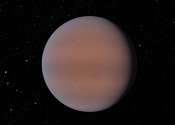Webb telescope makes first unequivocal detection of carbon dioxide in an exoplanet atmosphere
For the first time, astronomers have found unambiguous evidence of carbon dioxide in the atmosphere of an exoplanet (a planet outside our solar system).

For the first time, astronomers have found unambiguous evidence of carbon dioxide in the atmosphere of an exoplanet (a planet outside our solar system).
Astronomy
Aug 25, 2022
0
542

Archival observations of 25 hot Jupiters by the NASA/ESA Hubble Space Telescope have been analyzed by an international team of astronomers, enabling them to answer five open questions important to our understanding of exoplanet ...
Astronomy
Apr 25, 2022
0
385

The next step to understanding exoplanets is to understand their atmospheres better. Astronomers can determine a planet's mass, density, and other physical characteristics fairly routinely. But characterizing their atmospheres ...
Astronomy
Mar 16, 2022
0
35

Astronomers have identified two different cases of "mini-Neptune" planets that are losing their puffy atmospheres and likely transforming into super-Earths. Radiation from the planets' stars is stripping away their atmospheres, ...
Astronomy
Feb 3, 2022
5
878

The recently discovered planet TOI-674 b, a bit bigger than Neptune and orbiting a red-dwarf star about 150 light-years away, is a member of an exclusive club: Exoplanets, or planets around other stars, known to have water ...
Astronomy
Jan 14, 2022
0
166

Exoplanets, planets that orbit stars other than the sun, are found at distances very far from Earth. For example, the closest exoplanet to us, Proxima Centauri b, is 4.2 light years away, or 265,000 times the distance between ...
Astronomy
Jan 7, 2022
2
146

Ultra-hot Jupiters—named as such because of their physical similarities to the planet Jupiter—are exoplanets that orbit stars other than the sun with temperatures so high that the molecules in their atmospheres are completely ...
Space Exploration
Nov 10, 2021
0
21

A new study shows how the chemicals in an exoplanet's atmosphere can, in some cases, reveal whether or not the temperature on its surface is too hot for liquid water.
Astronomy
Oct 27, 2021
0
228

An international team of scientists, using the ground-based Gemini Observatory telescope in Chile, is the first to directly measure the amount of both water and carbon monoxide in the atmosphere of a planet in another solar ...
Space Exploration
Oct 27, 2021
0
1301

Most stars including the sun generate magnetic activity that drives a fast-moving, ionized wind and also produces X-ray and ultraviolet emission (often referred to as XUV radiation). XUV radiation from a star can be absorbed ...
Astronomy
Oct 4, 2021
0
191